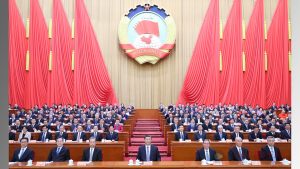
China Ramps Up Debt Collection from Poorest Nations
As outstanding debts to China soar to approximately $1.1 trillion, with over half of these loans now due, concerns escalate over the economic repercussions for 165 low- and middle-income countries involved in Chinese-backed projects. The debt, accrued since 2001 and exacerbated by the Belt and Road Initiative (BRI) launched in 2013, has raised alarm as the proportion of due loans is expected to reach 75 percent by 2030.
Initially envisioned to spur GDP growth in borrowing nations, many projects have fallen short of expectations, leading to challenges in repayment. The China-Pakistan Economic Corridor (CPEC), a flagship project under the BRI, exemplifies these difficulties. Despite a decade and $25 billion investment, the project has failed to deliver promised advancements in Pakistan’s energy infrastructure and connectivity. This has sparked criticism, with locals viewing China as the primary beneficiary while burdening Pakistan with debt.
Economists highlight the minimal spillover effects on GDP growth, coupled with the substantial impact on Pakistan’s debt, where 30 percent of external debt is owed to Chinese entities. The devaluation of the Pakistani rupee adds to the financial strain, making debt service payments more onerous. Despite these challenges, the next phase of CPEC is set to commence, raising concerns about further debt accumulation.
The issue extends beyond Pakistan, as 80 percent of Chinese loans to developing nations face financial distress. Accusations of irresponsible lending have arisen, exacerbated by high-interest rates and falling local currencies. While the BRI initially focused on massive infrastructure projects, China has shifted towards providing rescue loans, often in collaboration with Western financial institutions.
Approximately half of China’s non-emergency loans involve syndicates, with 80 percent of these partnerships featuring Western commercial banks or multilateral development banks. Despite this shift, China remains the world’s leading source of development finance, outspending any single Group of Seven (G7) country. However, the G7 collectively surpassed China’s spending in 2021, introducing alternatives to Beijing-led initiatives.
At the recent BRI summit, Chinese leader Xi Jinping emphasized reducing investment risk and focusing on “high-quality” investments. Despite a promise of $100 billion in new investment, much of it seems directed toward rescuing existing projects rather than initiating new ones. Additionally, China has assumed the role of a debt collector, discreetly seizing delinquent borrowers’ foreign currency reserves.
AidData, a research lab tracking China’s lending, suggests that China is now prioritizing troubled projects and distressed borrowers to avoid public backlash and gain a diplomatic advantage over G7 competitors. As diplomatic tensions rise globally, China faces challenges in its soft-power struggle, marked by setbacks and a declining favorability rating for the BRI.
While China grapples with its evolving approach, the United States and other developed nations are increasing overseas spending, presenting Western-led alternatives to the BRI. The competition for global influence intensifies as countries rally behind initiatives like the Global Gateway Project and the Partnership for Global Infrastructure and Investment.















Comments